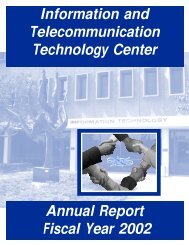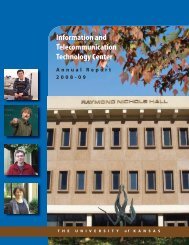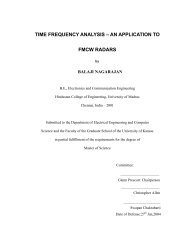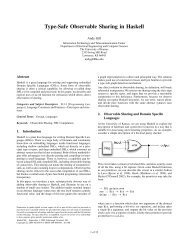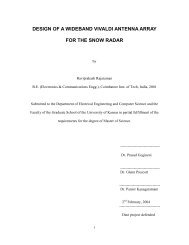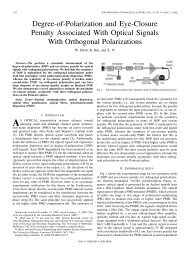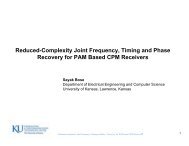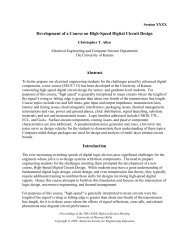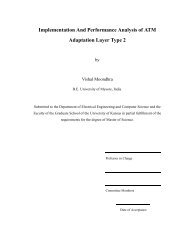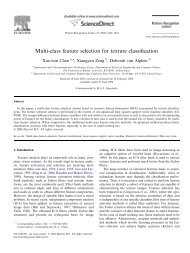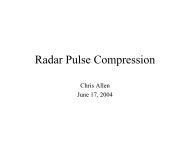A Hardware Implementation of the Soft Output Viterbi Algorithm for ...
A Hardware Implementation of the Soft Output Viterbi Algorithm for ...
A Hardware Implementation of the Soft Output Viterbi Algorithm for ...
Create successful ePaper yourself
Turn your PDF publications into a flip-book with our unique Google optimized e-Paper software.
A <strong>Hardware</strong> <strong>Implementation</strong> <strong>of</strong> <strong>the</strong> S<strong>of</strong>t<br />
<strong>Output</strong> <strong>Viterbi</strong> <strong>Algorithm</strong> <strong>for</strong> Serially<br />
Concatenated Convolutional Codes<br />
Brett Werling<br />
M.S. Student<br />
In<strong>for</strong>mation & Telecommunication Technology Center<br />
The University <strong>of</strong> Kansas
Overview<br />
• Introduction<br />
• Background<br />
• Decoding Convolutional Codes<br />
• <strong>Hardware</strong> <strong>Implementation</strong><br />
• Per<strong>for</strong>mance Results<br />
• Conclusions and Future Work<br />
2
Introduction<br />
3
• High-Rate High-Speed Forward Error Correction<br />
Architectures <strong>for</strong> Aeronautical Telemetry (HFEC)<br />
»ITTC – University <strong>of</strong> Kansas<br />
»2-year project<br />
»Sponsored by <strong>the</strong> Test Resource Management Center<br />
(TRMC) T&E/S&T Program<br />
»FEC decoder prototypes<br />
•SOQPSK-TG modulation<br />
»LDPC<br />
»SCCC<br />
•O<strong>the</strong>r modulations<br />
HFEC Project<br />
4
Motivation<br />
• There is a need <strong>for</strong> a convolutional code SOVA decoder<br />
block written in a hardware description language<br />
»Used multiple places within <strong>the</strong> HFEC decoder prototypes<br />
»VHDL code can be modified to fit various convolutional codes<br />
with relative ease<br />
• Future students must be able to use <strong>the</strong> implementation <strong>for</strong><br />
<strong>the</strong> SCCC decoder integration<br />
»Black box<br />
5
• Convolutional Codes<br />
• Channel Models<br />
Background<br />
• Serially Concatenated Convolutional Codes<br />
6
• Class <strong>of</strong> linear <strong>for</strong>ward error correction (FEC) codes<br />
• Use convolution to encode data sequences<br />
»Encoders are usually binary digital filters<br />
»Coding rate R = k / n<br />
•k input symbols<br />
•n output symbols<br />
Convolutional Codes<br />
• Structure allows <strong>for</strong> much flexibility<br />
»Convolutional codes operate on streams <strong>of</strong> data<br />
•Linear block codes assume fixed-length messages<br />
»Lower encoding and decoding complexity than linear block<br />
codes <strong>for</strong> same coding rates<br />
7
Convolutional Codes<br />
• Convolutional encoders are binary digital filters<br />
»FIR filters are called feed<strong>for</strong>ward encoders<br />
»IIR filters are called feedback encoders<br />
8
Convolutional Codes<br />
• A convolutional encoder can be thought <strong>of</strong> as a state<br />
machine<br />
»Current memory state and input affect output<br />
»Visualized in a state diagram<br />
9
• Ano<strong>the</strong>r representation is <strong>the</strong> trellis diagram<br />
»State diagram shown over time<br />
»Heavily used in many decoding algorithms<br />
•<strong>Viterbi</strong> algorithm<br />
•S<strong>of</strong>t output <strong>Viterbi</strong> algorithm<br />
•O<strong>the</strong>rs<br />
Convolutional Codes<br />
K K+ 1<br />
10
• Each stage in <strong>the</strong> trellis<br />
corresponds to one unit<br />
<strong>of</strong> time<br />
• Useful labels<br />
»State index: q<br />
•Starting state: q S<br />
•Ending state: q E<br />
»Edge index: e<br />
»Input / output:<br />
m(e) / c(e)<br />
Convolutional Codes<br />
11
Convolutional Codes<br />
• All <strong>of</strong> <strong>the</strong> in<strong>for</strong>mation in a trellis diagram can be contained in<br />
a simple lookup table<br />
»Each edge index corresponds to one row in <strong>the</strong> table<br />
12
• Convolutional Codes<br />
• Channel Models<br />
Background<br />
• Serially Concatenated Convolutional Codes<br />
13
• Communication links are affected by <strong>the</strong>ir environment<br />
»Thermal noise<br />
»Signal reflections<br />
»Similar communication links<br />
Channel Models<br />
• Two common channel models are used when evaluating<br />
<strong>the</strong> per<strong>for</strong>mance <strong>of</strong> a convolutional code<br />
»Binary symmetric channel (BSC)<br />
»Additive white Gaussian noise channel (AWGN)<br />
14
Channel Models - BSC<br />
• Binary symmetric channel<br />
(BSC)<br />
»Bit is transmitted ei<strong>the</strong>r correctly<br />
or incorrectly (binary)<br />
•Error occurs with probability p<br />
•Success occurs with probability 1 − p<br />
»Transmission modeled as a<br />
binary addition<br />
•XOR operation<br />
r = s<br />
+<br />
n<br />
15
Channel Models - AWGN<br />
• Additive white Gaussian noise<br />
channel (AWGN)<br />
»Bits are modulated be<strong>for</strong>e<br />
transmission (e.g. BPSK)<br />
•s contains values in {−1, +1}<br />
»Noise values are s<strong>of</strong>t (real)<br />
•Gaussian random variables<br />
»Transmission modeled as an<br />
addition <strong>of</strong> reals<br />
r = s + n<br />
16
• Convolutional Codes<br />
• Channel Models<br />
Background<br />
• Serially Concatenated Convolutional Codes<br />
17
Serially Concatenated Convolutional Codes<br />
• SCCC Encoder<br />
»Two differing convolutional codes are serially concatenated<br />
be<strong>for</strong>e transmission<br />
•Separated by an interleaver<br />
•Most previous concatenation schemes involved a convolutional<br />
code and a Reed Solomon code<br />
18
Serially Concatenated Convolutional Codes<br />
• SCCC Decoder<br />
»Two s<strong>of</strong>t-input s<strong>of</strong>t-output (SISO) convolutional decoders<br />
operate on <strong>the</strong> received sequence<br />
•Separated by an interleaver and de-interleaver<br />
•Multiple iterations be<strong>for</strong>e final output (e.g. 10)<br />
19
Serially Concatenated Convolutional Codes<br />
• SCCC Decoder<br />
»Two s<strong>of</strong>t-input s<strong>of</strong>t-output (SISO) convolutional decoders<br />
operate on <strong>the</strong> received sequence<br />
•Separated by an interleaver and de-interleaver<br />
•Multiple iterations be<strong>for</strong>e final output (e.g. 10)<br />
20
Decoding Convolutional Codes<br />
21
<strong>Viterbi</strong> <strong>Algorithm</strong><br />
• Most common algorithm <strong>for</strong> decoding a convolutionallyencoded<br />
sequence<br />
• Uses maximum likelihood sequence estimation to decode a<br />
noisy sequence<br />
»Uses trellis structure to compare possible encoding paths<br />
»Keeps track <strong>of</strong> only <strong>the</strong> paths that occur with maximum<br />
likelihood<br />
• Needs only two* passes over a received sequence to<br />
determine output<br />
»BCJR and Max-Log MAP algorithms need three<br />
»*Can use a windowing technique in <strong>the</strong> second pass<br />
22
<strong>Viterbi</strong> <strong>Algorithm</strong> – Forward Pass<br />
• Path metric updates<br />
»Previous path metrics are added to edge metric increments<br />
»Competing updated metrics are selected based on <strong>the</strong><br />
channel model being used<br />
•BSC<br />
•AWGN<br />
• Edge metric increments<br />
»Received symbols compared to edge data<br />
»Resulting increments are added to previous path metrics<br />
• Winning edges<br />
»Two edges merge, one is declared <strong>the</strong> winner (or survivor)<br />
23
<strong>Viterbi</strong> <strong>Algorithm</strong> – Backward Pass<br />
• Also known as <strong>the</strong> traceback loop<br />
• All known in<strong>for</strong>mation is processed to determine <strong>the</strong><br />
decoded sequence<br />
»Forward pass in<strong>for</strong>mation<br />
»Trellis lookup table<br />
• For long message lengths, a traceback window can<br />
improve per<strong>for</strong>mance<br />
»High probability that all paths converge to a single path some<br />
T time steps back<br />
24
S<strong>of</strong>t <strong>Output</strong> <strong>Viterbi</strong> <strong>Algorithm</strong><br />
• Extension <strong>of</strong> <strong>the</strong> <strong>Viterbi</strong> algorithm<br />
• Addition <strong>of</strong> s<strong>of</strong>t outputs allows it to be more useful in an<br />
SCCC system<br />
»Significant per<strong>for</strong>mance gain over use <strong>of</strong> <strong>Viterbi</strong> algorithm in<br />
an SCCC decoder<br />
25
S<strong>of</strong>t <strong>Output</strong> <strong>Viterbi</strong> <strong>Algorithm</strong><br />
• Same basic calculations as <strong>the</strong> <strong>Viterbi</strong> algorithm<br />
• Additional calculations<br />
»Competing path differences<br />
»Path decision reliabilities<br />
»Subtraction <strong>of</strong> prior probabilities<br />
• Same traceback window applies to <strong>the</strong> traceback loop<br />
»Includes additional reliability output calculation<br />
26
S<strong>of</strong>t <strong>Output</strong> <strong>Viterbi</strong> <strong>Algorithm</strong> – Example<br />
0<br />
00<br />
0<br />
01<br />
0<br />
10<br />
0<br />
11<br />
r 0 = {-1, -1}<br />
00<br />
01<br />
10<br />
11<br />
00<br />
01<br />
10<br />
11<br />
• Begin with an empty trellis and like-valued path metrics<br />
27
S<strong>of</strong>t <strong>Output</strong> <strong>Viterbi</strong> <strong>Algorithm</strong> – Example<br />
0<br />
00<br />
0<br />
01<br />
0<br />
10<br />
1<br />
-1<br />
0<br />
0<br />
-1<br />
1<br />
r 0 = {-1, -1}<br />
00<br />
01<br />
10<br />
00<br />
01<br />
10<br />
0<br />
11<br />
0<br />
0<br />
11<br />
11<br />
• Calculate <strong>the</strong> edge metric increments <strong>for</strong> <strong>the</strong> current trellis<br />
stage (in this case AWGN calculations)<br />
28
S<strong>of</strong>t <strong>Output</strong> <strong>Viterbi</strong> <strong>Algorithm</strong> – Example<br />
0<br />
00<br />
0<br />
01<br />
0<br />
10<br />
0<br />
11<br />
1<br />
-1<br />
0<br />
0<br />
-1<br />
1<br />
0<br />
0<br />
r 0 = {-1, -1}<br />
1<br />
-1<br />
-1<br />
1<br />
0<br />
0<br />
0<br />
0<br />
00<br />
01<br />
10<br />
11<br />
00<br />
01<br />
10<br />
11<br />
• Add <strong>the</strong> edge metric increments to <strong>the</strong>ir corresponding path<br />
metrics<br />
29
S<strong>of</strong>t <strong>Output</strong> <strong>Viterbi</strong> <strong>Algorithm</strong> – Example<br />
0<br />
00<br />
0<br />
01<br />
0<br />
10<br />
0<br />
11<br />
1<br />
-1<br />
0<br />
0<br />
-1<br />
1<br />
0<br />
0<br />
r 0 = {-1, -1}<br />
1<br />
Δ 0<br />
(0) = 2<br />
Δ 0<br />
(1) = 2<br />
Δ 0<br />
(2) = 0<br />
Δ 0<br />
(3) = 0<br />
-1<br />
-1<br />
1<br />
0<br />
0<br />
0<br />
0<br />
1<br />
00<br />
1<br />
01<br />
0<br />
10<br />
0<br />
11<br />
00<br />
01<br />
10<br />
11<br />
• Find <strong>the</strong> absolute difference between competing edges<br />
• Choose <strong>the</strong> winning metric as <strong>the</strong> new path metric<br />
30
S<strong>of</strong>t <strong>Output</strong> <strong>Viterbi</strong> <strong>Algorithm</strong> – Example<br />
0<br />
00<br />
0<br />
01<br />
0<br />
10<br />
0<br />
11<br />
1<br />
-1<br />
0<br />
0<br />
-1<br />
1<br />
0<br />
0<br />
r 0 = {-1, -1}<br />
1<br />
Δ 0<br />
(0) = 2<br />
Δ 0<br />
(1) = 2<br />
Δ 0<br />
(2) = 0<br />
Δ 0<br />
(3) = 0<br />
-1<br />
-1<br />
1<br />
0<br />
0<br />
0<br />
0<br />
1<br />
00<br />
1<br />
01<br />
0<br />
10<br />
0<br />
11<br />
00<br />
01<br />
10<br />
11<br />
• Mark <strong>the</strong> winning edges<br />
31
S<strong>of</strong>t <strong>Output</strong> <strong>Viterbi</strong> <strong>Algorithm</strong> – Example<br />
0<br />
00<br />
0<br />
01<br />
0<br />
10<br />
0<br />
11<br />
1<br />
-1<br />
0<br />
0<br />
-1<br />
1<br />
0<br />
0<br />
r 0 = {-1, -1}<br />
1<br />
Δ 0<br />
(0) = 2<br />
Δ 0<br />
(1) = 2<br />
Δ 0<br />
(2) = 0<br />
Δ 0<br />
(3) = 0<br />
-1<br />
-1<br />
1<br />
0<br />
0<br />
0<br />
0<br />
1<br />
00<br />
1<br />
01<br />
0<br />
10<br />
0<br />
11<br />
-1<br />
1<br />
0<br />
0<br />
1<br />
-1<br />
0<br />
0<br />
r 1 = {1, 1}<br />
Δ 1<br />
(0) = 1<br />
Δ 1<br />
(1) = 3<br />
Δ 1<br />
(2) = 1<br />
Δ 1<br />
(3) = 1<br />
0<br />
1<br />
2<br />
-1<br />
1<br />
0<br />
1<br />
0<br />
1<br />
00<br />
2<br />
01<br />
1<br />
10<br />
1<br />
11<br />
• The trellis after two time steps<br />
32
S<strong>of</strong>t <strong>Output</strong> <strong>Viterbi</strong> <strong>Algorithm</strong> – Example<br />
0/00<br />
1/11<br />
2<br />
0/01<br />
1/10<br />
1/10<br />
2<br />
3<br />
5<br />
• The traceback loop processes <strong>the</strong> trellis, starting with <strong>the</strong><br />
maximum likelihood path metric<br />
• Reliabilities are calculated using <strong>the</strong> values <strong>of</strong> Δ that were<br />
found during <strong>the</strong> <strong>for</strong>ward pass<br />
• <strong>Output</strong>s are calculated<br />
33
<strong>Hardware</strong> <strong>Implementation</strong><br />
34
<strong>Hardware</strong> <strong>Implementation</strong><br />
• Designed to work with a systematic rate R = ½ code<br />
»Systematic – message sequence appears within <strong>the</strong> encoded<br />
sequence<br />
• Design decisions<br />
»Traceback is done with register exchange<br />
»Overflow is prevented by clipping values at a maximum and<br />
minimum<br />
»Path metrics are periodically reduced to prevent <strong>the</strong>m from<br />
becoming too large<br />
»Two global design variables<br />
•Bit width: B<br />
•Traceback length: T<br />
35
<strong>Hardware</strong> <strong>Implementation</strong><br />
• Divided into four blocks<br />
»Metric Manager (MM)<br />
»Hard Decision Traceback Unit (HTU)<br />
»Reliability Traceback Unit (RTU)<br />
»<strong>Output</strong> Calculator (OC)<br />
36
<strong>Hardware</strong> <strong>Implementation</strong><br />
• Metric Manager<br />
»Handles storage and calculation <strong>of</strong> path metrics<br />
»Determines winning edges<br />
»Finds absolute path metric differences<br />
37
<strong>Hardware</strong> <strong>Implementation</strong><br />
• Hard Decision Traceback Unit<br />
»Keeps track <strong>of</strong> hard decision outputs<br />
»<strong>Output</strong>s hard decision comparison<br />
•Used by reliability update process<br />
38
<strong>Hardware</strong> <strong>Implementation</strong><br />
• Reliability Traceback Unit<br />
»Keeps track <strong>of</strong> reliabilities<br />
»Updates each reliability <strong>for</strong> every clock cycle<br />
39
<strong>Hardware</strong> <strong>Implementation</strong><br />
• <strong>Output</strong> Calculator<br />
»Determines final output <strong>of</strong> <strong>the</strong> decoder<br />
40
Per<strong>for</strong>mance Results<br />
41
Per<strong>for</strong>mance Results – S<strong>of</strong>tware Comparison<br />
• The VHDL decoder was compared with a reference<br />
decoder written in Matlab<br />
»Matlab version known to be correct<br />
• Simulations run <strong>for</strong> varying SNRs and traceback lengths<br />
»Noise values generated in Matlab<br />
»VHDL decoder simulated in ModelSim using Matlab data<br />
• Simulation requirements<br />
»Transmitted in<strong>for</strong>mation bits ≥ 1,000,000<br />
»In<strong>for</strong>mation bit errors ≥ 100<br />
42
Per<strong>for</strong>mance Results – S<strong>of</strong>tware Comparison<br />
B = 6<br />
B = 7<br />
B = 8<br />
B = 9<br />
• Traceback length T = 8<br />
43
Per<strong>for</strong>mance Results – S<strong>of</strong>tware Comparison<br />
B = 6 B = 7<br />
B = 8 B = 9<br />
• Traceback length T = 16<br />
44
Per<strong>for</strong>mance Results – S<strong>of</strong>tware Comparison<br />
• VHDL implementation approaches Matlab implementation<br />
as B increases<br />
»Expected result – higher precision<br />
• Increase in BER per<strong>for</strong>mance as traceback length<br />
increases<br />
»Also expected – designer must determine which traceback<br />
length provides “good enough” per<strong>for</strong>mance<br />
45
Per<strong>for</strong>mance Results – <strong>Hardware</strong><br />
T = 8<br />
T = 16<br />
• VHDL syn<strong>the</strong>sized using Xilinx ISE <strong>for</strong> <strong>the</strong> XC5VLX110T<br />
FPGA<br />
»All builds use < 12% <strong>of</strong> <strong>the</strong> slices available<br />
»Maximum clock speeds are fast enough to be used in <strong>the</strong><br />
SCCC decoder<br />
46
Conclusions and Future Work<br />
47
Summary <strong>of</strong> Results<br />
• The hardware implementation successfully per<strong>for</strong>ms <strong>the</strong><br />
s<strong>of</strong>t output <strong>Viterbi</strong> algorithm<br />
• For all bit widths tested, VHDL curve differs from Matlab<br />
curve by < 1 dB<br />
»For B = 8, difference is < 0.08 dB<br />
• Per<strong>for</strong>mance increases as traceback length increases<br />
»Trade<strong>of</strong>f between hardware size and decoder precision<br />
• Post-syn<strong>the</strong>sis results<br />
»Small – all designs < 12% slice utilization<br />
»Fast – clock speeds all > 129 MHz<br />
48
Future Work<br />
• New method <strong>of</strong> overflow prevention<br />
»Current design “clips” values, restricting <strong>the</strong>m to fall within a<br />
certain range<br />
»Work can be done to maintain precision<br />
• FPGA optimization<br />
»Current design approach is very much s<strong>of</strong>tware-based<br />
»Future designs can take advantage <strong>of</strong> FPGA features<br />
•Size and speed can be fur<strong>the</strong>r improved<br />
• Generalized trellis<br />
»Current design focuses on a particular trellis<br />
»Trellis-defining inputs could <strong>of</strong>fer more flexibility<br />
49
Questions?<br />
50




